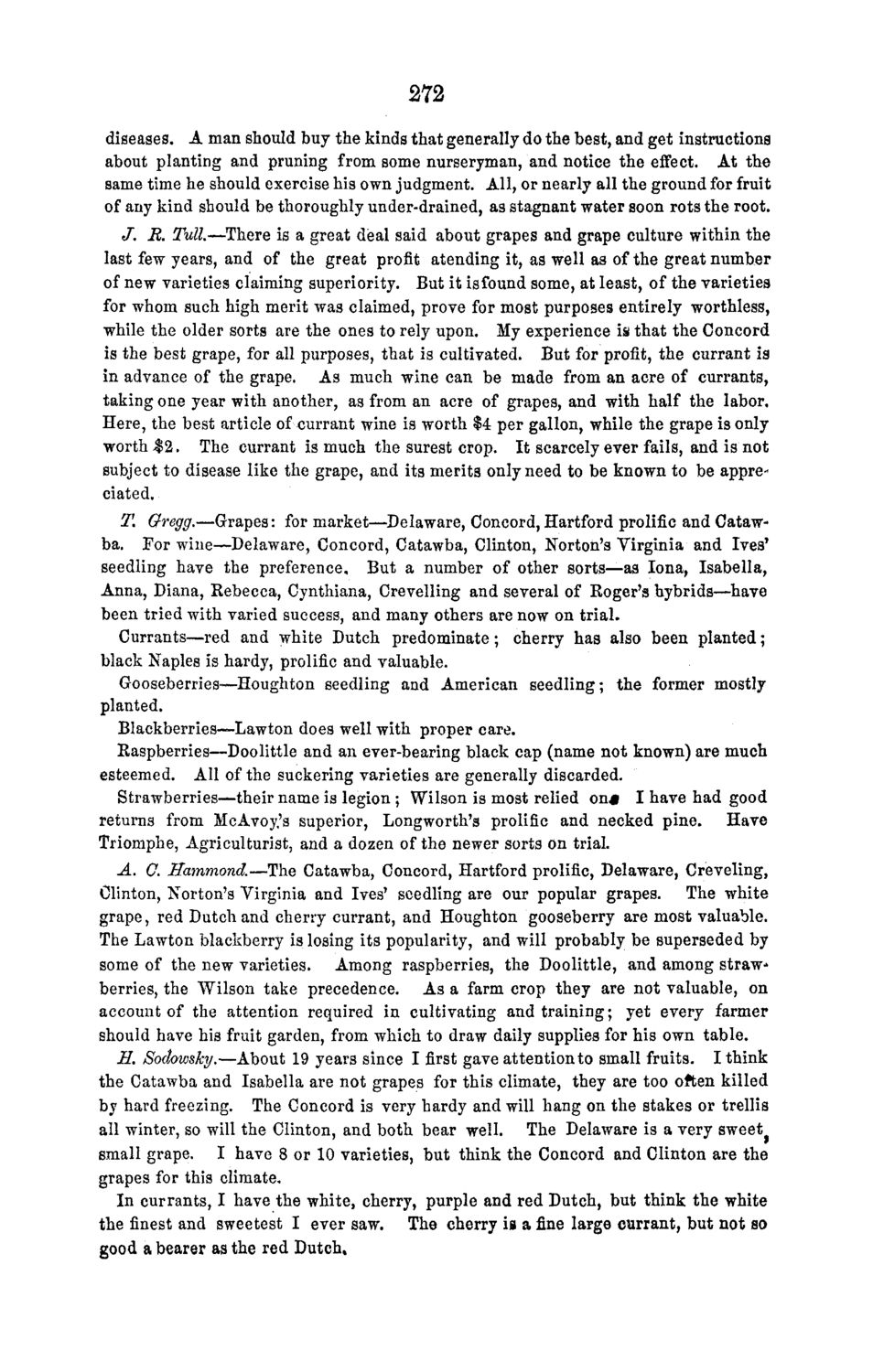| |
| |
Caption: Board of Trustees Minutes - 1868
This is a reduced-resolution page image for fast online browsing.

EXTRACTED TEXT FROM PAGE:
272 diseases. A man should buy the kinds that generally do the best, and get instructions about planting and pruning from some nurseryman, and notice the effect. At the same time he should exercise his own judgment. All, or nearly all the ground for fruit of any kind should be thoroughly under-drained, as stagnant water soon rots the root. / . R. Tull.—There is a great deal said about grapes and grape culture within the last few years, and of the great profit atending it, as well as of the great number of new varieties claiming superiority. But it is found some, at least, of the varieties for whom such high merit was claimed, prove for most purposes entirely worthless, while the older sorts are the ones to rely upon. My experience is that the Concord is the best grape, for all purposes, that is cultivated. But for profit, the currant is in advance of the grape. As much wine can be made from an acre of currants, taking one year with another, as from an acre of grapes, and with half the labor. Here, the best article of currant wine is worth $4 per gallon, while the grape is only worth $ 2 . The currant is much the surest crop. It scarcely ever fails, and is not subject to disease like the grape, and its merits only need to be known to be appreciated. T. Gregg.—Grapes: for market—Delaware, Concord, Hartford prolific and Catawba. For wine—Delaware, Concord, Catawba, Clinton, Norton's Yirginia and Ives' seedling have the preference. But a number of other sorts—as Iona, Isabella, Anna, Diana, Rebecca, Cynthiana, Crevelling and several of Roger's hybrids—have been tried with varied success, and many others are now on trial. Currants—red and white Dutch predominate; cherry has also been planted; black Naples is hardy, prolific and valuable. Gooseberries—Houghton seedling and American seedling; the former mostly planted. Blackberries—Lawton does well with proper care. Raspberries—Doolittle and an ever-bearing black cap (name not known) are much esteemed. All of the suckering varieties are generally discarded. Strawberries—their name is legion ; Wilson is most relied on* I have had good returns from McAvoy.'s superior, Longworth's prolific and necked pine. Have Triomphe, Agriculturist, and a dozen of the newer sorts on trial. A. C. Hammond.—The Catawba, Concord, Hartford prolific, Delaware, Creveling, Clinton, Norton's Virginia and Ives' seedling are our popular grapes. The white grape, red Dutch and cherry currant, and Houghton gooseberry are most valuable. The Lawton blackberry is losing its popularity, and will probably be superseded by some of the new varieties. Among raspberries, the Doolittle, and among straw* berries, the Wilson take precedence. As a farm crop they are not valuable, on account of the attention required in cultivating and training; yet every farmer should have his fruit garden, from which to draw daily supplies for his own table. JS. Soctow&ky.-—About 19 years since I first gave attention to small fruits. I think the Catawba and Isabella are not grapes for this climate, they are too often killed by hard freezing. The Concord is very hardy and will hang on the stakes or trellis all winter, so will the Clinton, and both bear well. The Delaware is a very sweet small grape. I have 8 or 10 varieties, but think the Concord and Clinton are the grapes for this climate. In currants, I have the white, cherry, purple and red Dutch, but think the white the finest and sweetest I ever saw. The cherry is a fine large currant, but not so good a bearer as the red Dutch,
| |